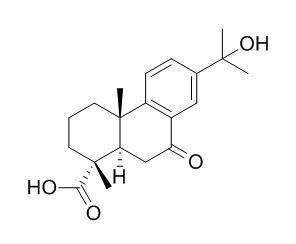15-Hydroxy-7-oxodehydroabietic acid
Standard reference
Inquire / Order:
manager@chemfaces.com
Technical Inquiries:
service@chemfaces.com
Tel:
+86-27-84237783
Fax:
+86-27-84254680
Address:
1 Building, No. 83, CheCheng Rd., Wuhan Economic and Technological Development Zone, Wuhan, Hubei 430056, PRC
Providing storage is as stated on the product vial and the vial is kept tightly sealed, the product can be stored for up to
24 months(2-8C).
Wherever possible, you should prepare and use solutions on the same day. However, if you need to make up stock solutions in advance, we recommend that you store the solution as aliquots in tightly sealed vials at -20C. Generally, these will be useable for up to two weeks. Before use, and prior to opening the vial we recommend that you allow your product to equilibrate to room temperature for at least 1 hour.
Need more advice on solubility, usage and handling? Please email to: service@chemfaces.com
The packaging of the product may have turned upside down during transportation, resulting in the natural compounds adhering to the neck or cap of the vial. take the vial out of its packaging and gently shake to let the compounds fall to the bottom of the vial. for liquid products, centrifuge at 200-500 RPM to gather the liquid at the bottom of the vial. try to avoid loss or contamination during handling.
Int J Mol Sci.2024, 25(19):10660.
Food Funct.2022, doi: 10.1039
Cell Death Differ.2021, 1-8.
Indian J Pharm Sci.2022, 84(4): 874-882.
Theranostics.2023, 13(9):3103-3116.
J Ethnopharmacol.2020, 260:112988.
Industrial Crops and Products2021, 163:113313.
Cell.2018, 172(1-2):249-261
Toxicol In Vitro.2022, 81:105346.
J Ethnopharmacol.2020, 249:112396
Related and Featured Products
Contact Dermatitis. 1988 Sep;19(3):166-74.
Contact allergy to dehydroabietic acid derivatives isolated from Portuguese colophony.[Pubmed:
3191677]
METHODS AND RESULTS:
7-oxodehydroabietic acid and 15-hydroxydehydroabietic acid were isolated as their methyl esters from Portuguese colophony of the gum rosin type and identified as contact allergens. Another oxidation product of dehydroabietic acid, 15-Hydroxy-7-oxodehydroabietic acid, was synthesized and identified as a component of Portuguese gum rosin. 7-oxodehydroabietic acid was found to a be a grade III allergen according to the GPMT method. Guinea pigs induced with gum rosin showed only a low response to the isolated compounds, while patients with a known allergy to gum rosin reacted to a greater extent.
CONCLUSIONS:
The results imply that the content of oxidized dehydroabietic acids in gum rosin is too low to give a marked sensitization in the animals. However, the patients might have come in contact with the allergens in technically modified rosins. The compounds showed a pattern of cross-reactivity in the animal experiments as well as among the patch tested patients.
J Mass Spectrom. 2005 May;40(5):675-87.
Direct exposure electron ionization mass spectrometry and gas chromatography/mass spectrometry techniques to study organic coatings on archaeological amphorae.[Pubmed:
15739159]
Two different analytical approaches, direct exposure electron ionization mass spectrometry (DE-MS) and gas chromatography/mass spectrometry (GC/MS), were compared in a study of archaeological resinous materials.
METHODS AND RESULTS:
DE-MS was found to be an efficient fingerprinting tool for the fast screening of organic archaeological samples and for providing information on the major components. GC/MS appeared to be more efficient in unravelling the sample composition at a molecular level, despite the long analysis time and the need for a wet chemical pretreatment. Both procedures were applied to characterize the organic material present as coatings in Roman and Egyptian amphorae. DE-MS successfully identified abietanic compounds, hence a diterpenic resinous material could be identified and its degree of oxidation assessed. GC/MS enabled us to identify dehydroabietic acid, 7-oxodehydroabietic acid, 15-Hydroxy-7-oxodehydroabietic acid, 15-hydroxydehydroabietic acid, retene, tetrahydroretene, norabietatriene, norabietatetraene and methyl dehydroabietate. These oxidized and aromatized abietanes provided evidence that the amphorae examined were waterproofed with a pitch produced from resinous wood of plants from the Pinaceae family.
CONCLUSIONS:
The chemometric evaluation of the GC/MS data highlighted significant chemical differences between the pitches found in the two archaeological sites, basically related to differences in the production techniques of the materials and in their degradation pathways.



